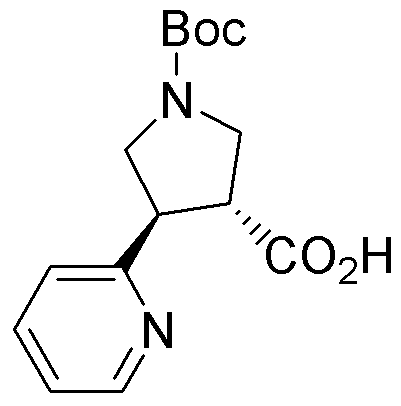Boc-(±)-trans-4-(2-pyridinyl)pyrrolidine-3-carboxylic acid is widely utilized in research focused on:
- Pharmaceutical Development: This compound serves as a key intermediate in the synthesis of various pharmaceuticals, particularly in the development of drugs targeting neurological disorders.
- Peptide Synthesis: It is commonly used in solid-phase peptide synthesis, allowing for the efficient construction of complex peptide sequences with enhanced stability and bioactivity.
- Research in Medicinal Chemistry: The compound is employed in the design of novel ligands for receptors, facilitating the discovery of new therapeutic agents with improved efficacy and selectivity.
- Biochemical Studies: It acts as a valuable tool in studying enzyme mechanisms and interactions, helping researchers understand biological processes at a molecular level.
- Material Science: This chemical is explored in the development of functional materials, such as polymers and coatings, that require specific chemical properties for enhanced performance.
General Information
Properties
Safety and Regulations
Applications
Boc-(±)-trans-4-(2-pyridinyl)pyrrolidine-3-carboxylic acid is widely utilized in research focused on:
- Pharmaceutical Development: This compound serves as a key intermediate in the synthesis of various pharmaceuticals, particularly in the development of drugs targeting neurological disorders.
- Peptide Synthesis: It is commonly used in solid-phase peptide synthesis, allowing for the efficient construction of complex peptide sequences with enhanced stability and bioactivity.
- Research in Medicinal Chemistry: The compound is employed in the design of novel ligands for receptors, facilitating the discovery of new therapeutic agents with improved efficacy and selectivity.
- Biochemical Studies: It acts as a valuable tool in studying enzyme mechanisms and interactions, helping researchers understand biological processes at a molecular level.
- Material Science: This chemical is explored in the development of functional materials, such as polymers and coatings, that require specific chemical properties for enhanced performance.
Documents
Safety Data Sheets (SDS)
The SDS provides comprehensive safety information on handling, storage, and disposal of the product.
Product Specification (PS)
The PS provides a comprehensive breakdown of the product’s properties, including chemical composition, physical state, purity, and storage requirements. It also details acceptable quality ranges and the product's intended applications.
Certificates of Analysis (COA)
Search for Certificates of Analysis (COA) by entering the products Lot Number. Lot and Batch Numbers can be found on a product’s label following the words ‘Lot’ or ‘Batch’.
*Catalog Number
*Lot Number
Certificates Of Origin (COO)
This COO confirms the country where the product was manufactured, and also details the materials and components used in it and whether it is derived from natural, synthetic, or other specific sources. This certificate may be required for customs, trade, and regulatory compliance.
*Catalog Number
*Lot Number
Safety Data Sheets (SDS)
The SDS provides comprehensive safety information on handling, storage, and disposal of the product.
DownloadProduct Specification (PS)
The PS provides a comprehensive breakdown of the product’s properties, including chemical composition, physical state, purity, and storage requirements. It also details acceptable quality ranges and the product's intended applications.
DownloadCertificates of Analysis (COA)
Search for Certificates of Analysis (COA) by entering the products Lot Number. Lot and Batch Numbers can be found on a product’s label following the words ‘Lot’ or ‘Batch’.
*Catalog Number
*Lot Number
Certificates Of Origin (COO)
This COO confirms the country where the product was manufactured, and also details the materials and components used in it and whether it is derived from natural, synthetic, or other specific sources. This certificate may be required for customs, trade, and regulatory compliance.


